
Lyon Sprague de Camp was an American writer of science fiction, fantasy and non-fiction. In a career spanning 60 years, he wrote over 100 books, including novels and works of non-fiction, including biographies of other fantasy authors. He was a major figure in science fiction in the 1930s and 1940s.

The Dragon of the Ishtar Gate is a historical novel by American writer L. Sprague de Camp, first published in hardcover by Doubleday in 1961, and in paperback by Lancer Books in 1968. The first trade paperback edition was issued by The Donning Company in 1982. The book was reissued with a new introduction by Harry Turtledove as a trade paperback and ebook by Phoenix Pick in September 2013. It is the third of de Camp's historical novels in order of writing, and earliest chronologically. It is set in 466-465 BCE, the last years of the reign of King Xerxes I of Persia.

Man and Power: the Story of Power from the Pyramids to the Atomic Age is a science book for children by L. Sprague de Camp, illustrated with documents, photographs by Russ Kinne, Roman Vishniac, and others, and paintings by Alton S. Tobey, first published in hardcover by Golden Press in 1961.

Darwin and His Great Discovery is a science book for young adults by L. Sprague de Camp and Catherine Crook de Camp, first published by Macmillan in 1972.

The Day of the Dinosaur is a science book by L. Sprague de Camp and Catherine Crook de Camp, illustrated with plates. It was first published in hardcover by Doubleday in 1968, and in paperback by Curtis Books in 1970 or 1971. A second hardcover edition was issued by Bonanza Books in 1985. The first chapter was reprinted as "One Day in the Cretaceous" in the de Camps's collection Footprints on Sand.

The Arrows of Hercules is an historical novel by American writer L. Sprague de Camp, first published in hardback by Doubleday in 1965 and in paperback by Curtis Books in 1970. The book was reissued with a new introduction by Harry Turtledove as a trade paperback and ebook by Phoenix Pick in April 2014. It is the fourth of de Camp's historical novels in order of writing, and second chronologically, set in the time of Dionysios I of Syracuse at the end of the 5th and beginning of the 4th centuries BC.
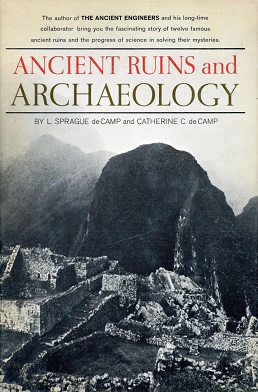
Ancient Ruins and Archaeology is a 1964 science book by L. Sprague de Camp and Catherine Crook de Camp, one of their most popular works. It was first published in hardcover by Doubleday in 1964, and reprinted under the same title by Barnes & Noble Books in 1992. The first British and paperback edition was issued by Fontana in 1972 under the title Citadels of Mystery, which was the de Camps' original working title; this title was retained by the first American paperback edition, issued by Ballantine Books in April 1973 and reprinted in February 1974. Translations into French, German and Portuguese have also appeared. Portions of the work had previously appeared as articles in the magazines Astounding Science Fiction, Fate, Frontiers, Natural History Magazine, Other Worlds Science Stories, Science Fiction Quarterly, and Travel.

Spirits, Stars, and Spells: The Profits and Perils of Magic is a 1966 history book by L. Sprague de Camp and Catherine Crook de Camp, published by Canaveral Press. The book sold slowly, and the remaining stock was taken over by Owlswick Press and sold under its own name with new dust jackets in 1980. It has been translated into Polish.

Lands Beyond is a study of geographical myths by L. Sprague de Camp and Willy Ley, first published in hardcover by Rinehart in 1952, and reissued by Barnes & Noble in 1993. It has been translated into French, Spanish, Portuguese, and Italian. It was the winner of the 1953 International Fantasy Award for nonfiction.

The Best of L. Sprague de Camp is a collection of writings by American science fiction and fantasy author L. Sprague de Camp, first published in hardback by Nelson Doubleday in February 1978 and in paperback by Ballantine Books in May of the same year as a volume in its Classic Library of Science Fiction. The book was reprinted by Ballantine in May 1986. It was reissued in trade paperback and ebook editions by Phoenix Pick in December 2014. It has also been translated into German.
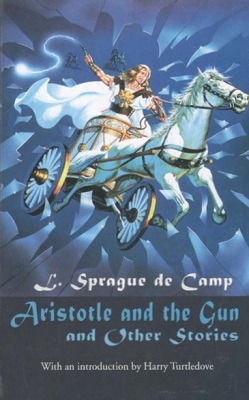
Aristotle and the Gun and Other Stories is a collection of short stories by American science fiction and fantasy author L. Sprague de Camp. It was published in hardcover in August 2002 by the Gale Group as part of its Five Star Speculative Fiction Series.

Divide and Rule is a 1948 collection of two science fiction novellas by American writer L. Sprague de Camp, first published in hardcover by Fantasy Press, and later reissued in paperback by Lancer Books in 1964. The collected pieces were previously published in 1939 and 1941 in the magazines Unknown and Astounding. The first stand-alone edition of the title story was published as a large-print hardcover by Thorndike Press in September 2003. An E-book edition of the title story was issued by Gollancz's SF Gateway imprint on September 29, 2011 as part of a general release of de Camp's works in electronic form.

The Incorporated Knight is a fix-up fantasy novel by American writers L. Sprague de Camp and Catherine Crook de Camp, the first book in their sequence of two Neo-Napolitanian novels. Chapters 1-5 first appeared as L. Sprague de Camp's short stories "Two Yards of Dragon", "The Coronet", "Spider Love" and "Eudoric's Unicorn" in Flashing Swords!, The Magazine of Fantasy and Science Fiction and The Year's Best Fantasy Stories in 1976-1977. The complete novel was first published in hardcover by Phantasia Press in August 1987, and in paperback by Baen Books in September 1988, with a trade paperback edition, also from Baen, following in 1991. An E-book edition was published by Gollancz's SF Gateway imprint on September 29, 2011 as part of a general release of de Camp's works in electronic form.
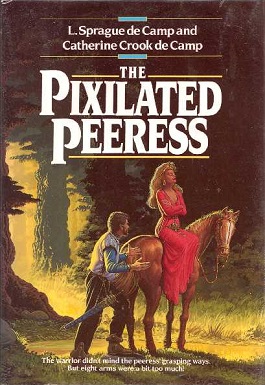
The Pixilated Peeress is a fantasy novel by American writers L. Sprague de Camp and Catherine Crook de Camp. It is the second book in their sequence of two Neo-Napolitanian novels, following The Incorporated Knight. It was first published in hardcover by Del Rey Books in August 1991, and in paperback by the same publisher in September 1992. An E-book edition was published by Gollancz's SF Gateway imprint on September 29, 2011 as part of a general release of de Camp's works in electronic form.
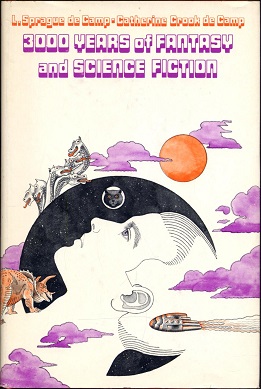
3000 Years of Fantasy and Science Fiction is an anthology of fantasy and science fiction short stories, edited by American writers L. Sprague de Camp and Catherine Crook de Camp. It was first published in both hardcover and paperback by Lothrop Lee & Shepard in 1972. It was the first such anthology assembled by the de Camps, preceding their later Tales Beyond Time (1973).

Rogue Queen is a science fiction novel by American writer L. Sprague de Camp, the third book in his Viagens Interplanetarias series. It was first published in hardcover by Doubleday in 1951, and in paperback by Dell Books in 1952. A later hardcover edition was issued by The Easton Press in its The Masterpieces of Science Fiction series in 1996; later paperback editions were issued by Ace Books (1965) and Signet Books. A trade paperback edition was issued by Bluejay Books in June 1985. The first British edition was published in paperback by Pinnacle Books in 1954; a British hardcover reprint followed from Remploy in 1974. The novel has been translated into Portuguese, Italian, French and German. An E-book edition was published by Gollancz's SF Gateway imprint on September 29, 2011 as part of a general release of de Camp's works in electronic form. Arc Manor's Phoenix Pick imprint reissued the book in both trade paperback and e-book format in January 2012.
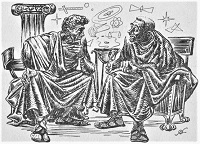
"Aristotle and the Gun" is a time travel and alternate history science fiction story by American writer L. Sprague de Camp.

Mission: Earth, Voyage to the Home Planet is a children's literature book by science writer June A. English and astronaut Thomas David Jones that was published in 1996 by Scholastic. Jones was among the crew members of the Space Shuttle Endeavour during an eleven-day mission in space, which was launched in April 1994 to study the ecological well-being of Earth using specialized radar technology. The book, which is illustrated with radar images and picturesque photographs, chronicles the mission and Jones' experiences of it.

"Divide and Rule" is a science fiction novella by American writer L. Sprague de Camp. It was first published as a serial in the magazine Unknown from April to May, 1939 and first appeared in book form in de Camp's collection Divide and Rule. The story was revised for book publication. The first stand-alone book edition of the story was published as a large-print hardcover by Thorndike Press in September 2003. An E-book edition of the story was issued by Gollancz's SF Gateway imprint on September 29, 2011 as part of a general release of de Camp's works in electronic form.
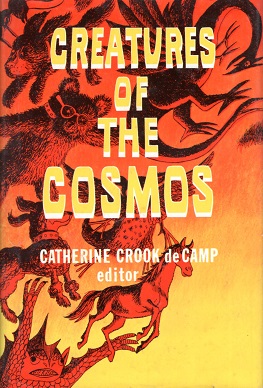
Creatures of the Cosmos is an anthology of fantasy and science fiction short stories for younger readers, edited by Catherine Crook de Camp. It was first published in hardcover by Westminster Press in 1977. It was the third such anthology assembled by de Camp, following the earlier 3000 Years of Fantasy and Science Fiction (1972) and Tales Beyond Time (1973), both of which she edited together with her husband L. Sprague de Camp.


















